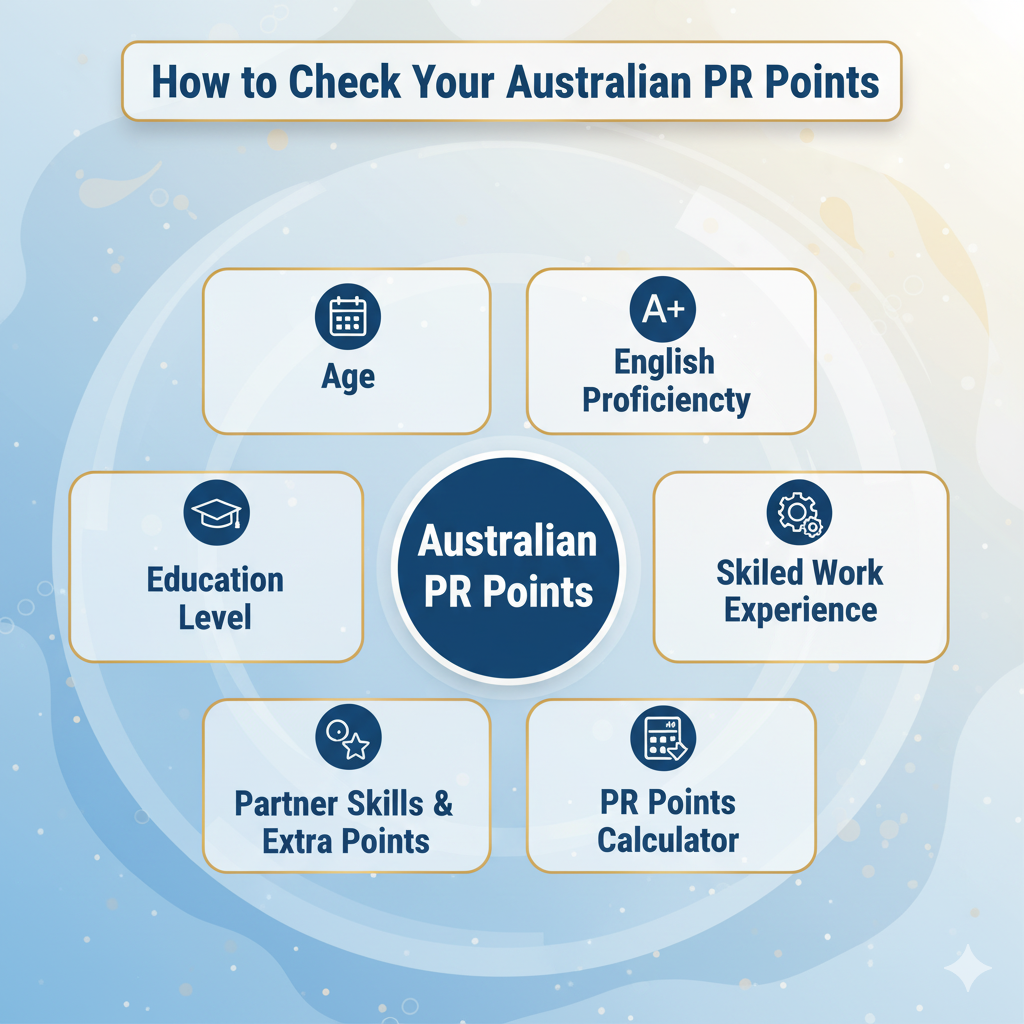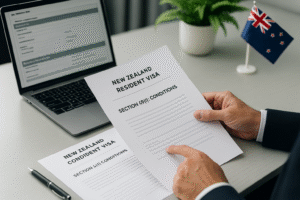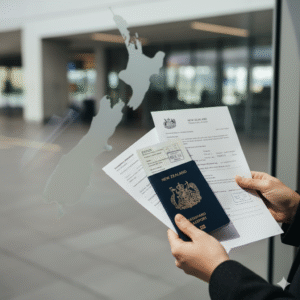A Complete Guide to Checking Your Points for Australian Immigration
Doesn’t it sound exciting to move to Australia? But before you start packing your bags, you need to know about the points-based immigration system. Your points score will determine whether or not you can get an invitation to apply for permanent residency if you want to apply for a skilled visa.
The good news? It may seem hard to figure out how many points you have, but it’s not. You can quickly figure out where you stand and what you need to do to raise your score if you have the right information and tools. This guide will show you everything you need to know about how to check your points for Australian immigration, from how the system works to how to use official calculators and raise your score.
Why does Australia have a points system?
Australia’s points-based immigration system was made to bring in skilled workers who can help the economy. The system looks at things like a candidate’s age, education, work experience, and ability to speak English.
This is how the Australian government makes sure that immigrants have the skills and qualifications the country needs. If you have more points, you’re more likely to be able to fit in with the Australian workforce and society.
To get an invitation for most skilled migration visas, you need at least 65 points. But depending on your job and the current trends in immigration, you might need a higher score to get an invitation. For instance, a lot of people who apply for the popular Subclass 189 visa find that getting 75 points or more makes their chances much better.
Important Things That Decide Your Points
Understanding what contributes to your points score is essential. Let’s look at the main groups:
Age
Your age when you were invited has a big impact on how many points you get:
- 25 points for ages 18 to 24
- 30 points for ages 25 to 32
- 25 points for people between the ages of 33 and 39
- 15 points for people aged 40 to 44
- 45 and up: 0 points
You can get the most points for age if you are between 25 and 32 years old.
Ability to Speak English
People really value having good English skills. You can get points for taking the IELTS, PTE Academic, TOEFL iBT, or other approved tests:
- 0 points for good English
- 10 points for being good at English
- 20 points for better English
Getting “Superior English” (usually an IELTS score of 8 or higher in all parts) can really help your application.
Qualifications for Education
Your score also takes into account your highest level of education:
- 20 points for a doctorate from an Australian university or a recognized qualification
- 15 points for a bachelor’s degree or higher
- 10 points for a diploma or trade qualification
- 10 points for an award or qualification that the assessing authority recognizes
You might be able to get extra points under the Australian study requirement if you got your degree in Australia.
Experience at Work
You get points for both Australian and overseas work experience, but Australian experience is worth more points:
Jobs that require skills outside of Australia:
- Three to four years: five points
- 10 points for 5 to 7 years
- 8 to 10 years: 15 points
Skilled employment in Australia: 1-2 years: 5 points
- 10 points for 3–4 years
- 15 points for 5–7 years
- 20 points for 8 to 10 years
Your work experience must be in the job you chose or a field that is very similar to it.
Other Factors
There are a few other things that can help you get more points:
- Skills of a partner: You can get 5 to 10 points if your partner is also the right age, speaks English, and has the right qualifications.
- Australian study requirement: Five points for finishing at least two years of school in Australia
- Professional year in Australia: Finishing a professional year program in your field: 5 points
- 5 points for studying in regional Australia:
- 10 points for having a master’s or doctorate degree in a STEM field from an Australian school.
- Community language: 5 points for having accredited credentials in a certain community language.
How to Figure Out Your Points Step by Step
It’s easy to figure out your Australian immigration points if you follow these steps:
Step 1: Check Your Occupation
First, make sure that your job is on the list of skilled occupations that apply to you. Australia has a number of lists that depend on the type of visa you want. You can only move forward if your job is on the right list.
Step 2: Use the Official PR Points Calculator
The Australian Department of Home Affairs has an official points calculator on their website. You can enter your information into this tool and see your points score right away.
To use a PR points calculator, you will need to give it the following information:
- How old you are
- Scores on the English test
- Qualifications for education
- Experience working in Australia and other countries
- Any other things that apply to you
Step 3: Get the documents you need.
When you add up your points, make sure you have proof for each claim. When you send in your Expression of Interest (EOI) and visa application, you’ll need these papers. This includes:
- Results of the language test
- Transcripts and degrees from school
- Letters of recommendation for jobs
- Results of the skills test
Step 4: Check Your Math
Make sure your calculations are correct by checking them again. If you falsely claim points, your visa application may be denied and you may have trouble with future applications.

How to Read the Australia PR Points Table
The Australia PR points table is updated often to show what the current immigration priorities are. As of 2025, the minimum points requirement remains 65 for most skilled visas, but competition varies by occupation and visa subclass.
It’s especially important for international students studying in Australia to understand the PR points system. You can accumulate points through:
- Getting your Australian qualification (5 points)
- Getting skilled work experience in Australia while you study or after you finish
- Getting better scores in English
- Finishing a professional year program
A lot of international students want to know, “How many points do I need for Australia PR?” While 65 points is the minimum, getting an invitation usually takes 75–85 points or more, depending on how in-demand your job is.
Tools and Resources for Checking Your Points
There are a few other tools you can use to figure out if you qualify besides the official calculator:
Website of the Department of Home Affairs
The Department of Home Affairs website is the best place to go to find out how many points you have. You can send in an EOI through their SkillSelect system and see how you stack up against other candidates.
Organizations that assess skills
Certain authorized bodies must evaluate people in certain jobs. These organizations evaluate whether your qualifications and experience meet Australian standards for your nominated occupation. Before you can get points for your qualifications and work experience, you must have your skills tested.
Free Online Calculators
A lot of migration websites have free PR points calculators. These can give you a quick idea, but you should always check your results with official sources. These calculators are good for making plans at first, but they shouldn’t be used instead of getting help from a professional for complicated cases.
Things to Think About When Applying for a Regional Visa
If you’re thinking about getting a regional visa, like the Subclass 491, the points system is a little different. Regional visas give you an extra 15 points for nomination or sponsorship, which makes them a good choice for people who don’t meet the requirements for general skilled migration visas.
A 491 visa points calculator will take into account:
- All standard points categories
- Nomination from the region (15 points)
- Any requirements that are specific to a state or territory
If your job is in demand in regional areas, regional visas can be a great way to get permanent residency.
How to Get More Points
Not quite there with 65 points? Here are proven strategies to boost your score:
Get a better score in English
If you spend time working on your English, you could get up to 20 points more. You might want to take more language classes and retake your English test. The difference between Proficient English (10 points) and Superior English (20 points) could make or break your application.
Get more experience at work
Every year of skilled work experience you have adds points to your total. It might be a good idea to wait before sending in your EOI if you’re close to the next level (for example, if you’re at 4 years and 5 years would give you more points).
Pursue Further Education
Getting a higher degree can help you get more points. Completing an Australian qualification not only gives you more education points, but it may also make you eligible for the Australian study requirement bonus if you are an international student.
Finish a Professional Year
If you’ve studied accounting, IT, or engineering in Australia, a professional year program gives you 5 extra points and valuable work experience in Australia.
Think about Partner Points
You can get more points if your partner meets certain requirements, like having a good skills assessment and being able to speak English well.
Explore Regional Opportunities
If you study or work in a region, you can get 5 extra points. If you apply for a regional visa, you can get even more points.
Frequently Asked Questions About the Points
Is 75 Points Enough to Get an 189 Visa?
The Subclass 189 visa requires at least 65 points, but having 75 points greatly increases your chances of getting an invitation. The score you need depends on the job and the round. Some jobs that are in high demand may send out invitations at 65 points, while jobs that are very competitive may need 85 points or more.
When will I receive an invitation?
The amount of time you have to wait after sending in your EOI depends on your points score and job. People with higher scores and jobs that are in high demand usually get invitations faster. There are regular invitation rounds, and you can see where you stand in SkillSelect.
Can I change my EOI?
Yes, you can change your EOI at any time if your situation changes, like if you get more work experience or do better on your English test. Your current points score will determine how your EOI is ranked.
Why Getting Professional Help Is Important
You can figure out your own points, but the Australian immigration system can be hard to understand. Small mistakes on your application or missed chances to get more points can slow down your move.
Working with immigration experts who have been around for a while makes sure that:
- Your points count is correct
- You are taking all of the points you can get.
- Your application is finished and all the paperwork is in order.
- You know what the best path is for your situation.
- At Business Kiwi, we help skilled migrants understand their options an
the best applications for Australian immigration. Our team is up to date on the most recent policy changes and can give you advice that is specific to your situation.
Make Progress Toward Your Australian Dream
The first step to making your dream of moving to Australia come true is to learn how to check your points. If you’re an international student thinking about your future, a skilled worker looking at job opportunities abroad, or someone looking into regional pathways, knowing where you stand can help you plan better.
To get your starting score, use the official PR points calculator. After that, think about what you can do better to increase your chances of getting an invitation. Keep in mind that the immigration situation changes all the time, so it’s important to keep up with the latest rules and chances.
Are you ready to begin your journey to immigrate to Australia with help from experts? Business Kiwi can help you figure out the points system, find the best visa option for your situation, and make sure your application is as strong as it can be. Call us today to talk about your choices and start your new life in Australia.







